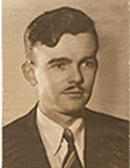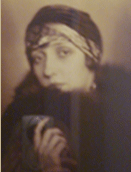

My Mother in Paris
It’s a long time since my mother, Minerva Clawson Primm, having just got back from a long stay in Europe, asked Charles Quest, an up-and-coming artist known nationally for his woodcuts, if she could pose for him nude. He needn’t pay her, she told him. She just wanted to be the subject. Quest must have been an elegant presence at that time, a well-groomed, smallish man, much like my mother’s uncles, his hair done in the style that ended with the fall of the Third Reich, pulled all the way over to one side from the other, and his mustache well-trimmed and pencil-thin.

|
 Charles Quest |

|
 Minerva Clawson Primm |
When I took my first class in figure drawing with Quest years later, he was an overweight “old” man in his fifties who ate baby food from jars for lunch because he had stomach problems. He was still groomed with style, but his hair had turned pure white. He was a kind man, the perfect teacher for terrified art school freshmen. Most of us had never seen a body totally naked other than our own in a full-length mirror.
Our first model was a tall African-American woman with large breasts, close-cut hair, small head, and slender ankles and wrists. Her beauty was greater than anything we students could appreciate at the time. I have never forgotten the shape and grace of her body as she took a striding pose facing forward and then twisted her ribs to one side, causing her breasts to shift to a different perspective from the rest of her. “Draw the big shapes,” Quest would call out. “Big Mary” was her model’s name to distinguish her from “Little Mary,” another figure model at the school.
My mother arrived at Quest’s studio and was greeted by his wife Dorothy Quest who was well known in St. Louis for her pastel portraits of children. Dorothy Quest remained nearby throughout the session while her husband painted an alla prima sketch of my nude mother in oil. The year must have been 1931 or ‘32.
Clawson Primm, my mother’s uncle, whose name was given to her as a middle name, took my mother to Europe in 1928 when she was 18 in order to get her out of her mother’s house. My grandmother, a devout Catholic, Lulu Gervaise Coiteaux Primm, had such loud screaming fights with my mother that their voices could be heard a block away.
In Paris, Clawson took my mother to the Rodin Museum. There they saw cast bronze sculptures of bodies frozen in the midst of actions, solid, yet twisting in poses that showed the thrill of being alive through expressions of pain, endurance, ecstasy, love, and the whole miserable human condition. My mother claimed that on the boat on the way home from Europe Edith Sitwell had asked her what her favorite work of art was. Bernini’s Ecstasy of St. Teresa was my mother’s quick reply. Sitwell told her condescendingly that as she grew older my mother would realize her folly and would come to understand that the statues of Michelangelo were far superior to Bernini’s St. Teresa. Sitwell’s great-nephew and biographer William Sitwell describes her as never having had a passionate relationship. “Edith was returned unopened,” one biographer wrote.
Clawson, a descendent of Huguenots and a product of the Victorian age, fully appreciating and comprehending the revolutionary nature and cultural impact of Rodin’s work, pulled my mother out of the Rodin Museum after a few minutes, saying that no niece of his was going to look at all of those naked bodies.
Throughout my childhood my mother ranted and raved about Uncle Clawson’s having deprived her of Rodin’s artwork. He was a prude, she said. In his treachery he would repress the pagan underpinnings of the Catholic faith that my mother used as touchstones in charting her life. Small reproductions of Botticelli’s The Birth of Venus and Primavera were always on view in her dining room.
In my mother’s household Venus ruled over the Virgin Mary, and the baby Jesus was more a god of fertility than anything else.
All those naked bodies that my mother was not allowed to see and to enjoy in 1928 now grace the models’ platform at my drawing studio in SoHo, Spring Studio, on the corner of Spring and Lafayette, seven days a week, year-round, in a never-ending flow of twisting poses that show the thrill of being alive through expressions of pain, endurance, ecstasy, love, and the whole miserable human condition.
On the other hand, Uncle Clawson died in Rome in 1931 and his body rests in peace in the Protestant Cemetery there, headstone number S2522. What is it that they say about art all the time? Ars longa, vita brevis.


copyright © 2015 Minerva Durham
 index
index